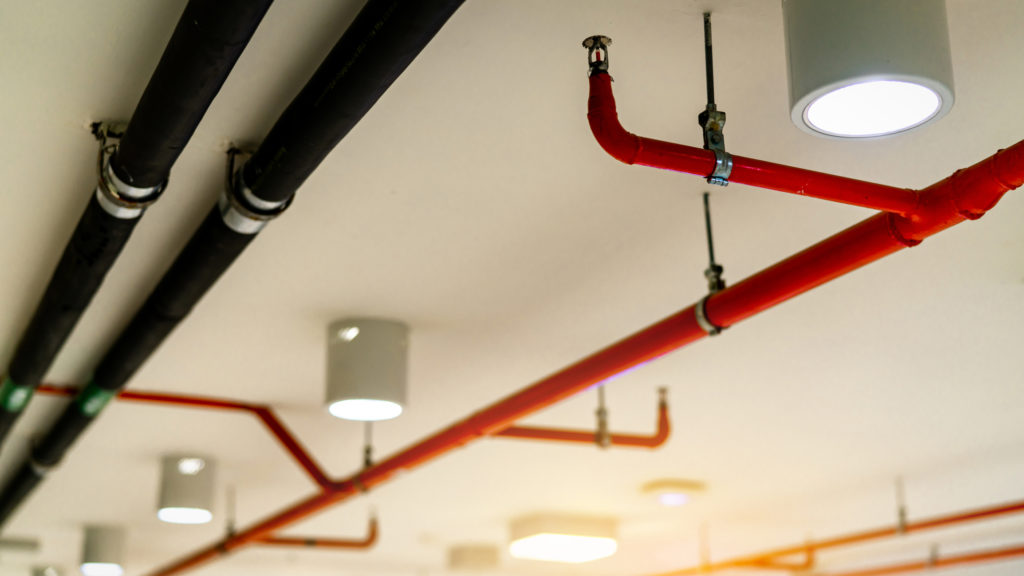A Beginner’s Guide to Fire Sprinkler Systems

Fires start and spread in unpredictable ways, potentially blazing out of control within minutes of when they start. Flames and smoke enter walls, ceilings, vents, and stairwells, causing significant damage and causalities. Fire sprinkler systems are designed to save lives and property, extinguishing a fire or keeping it under control long enough for firefighters to arrive. They’re a critical component of any fire safety protection program, yet many people are unclear on why they’re needed or how they work.
Here’s everything you need to know about commercial fire sprinkler systems, including the different types, how they function, and why they’re essential to proper building maintenance and employee safety.
Types of Commercial Fire Sprinklers
The National Fire Protection Association permits four types of fire sprinkler systems for commercial use: wet, dry, pre-action, and deluge.
Wet Pipe Sprinkler Systems
Wet pipe sprinklers are the most common and reliable type for commercial buildings, offering a quick response to fire. Because water is always present in the pipes, it’s immediately released when one or more sprinkler heads detect heat.
The system operates on a relatively simple yet effective principle, with each sprinkler head having a heat-sensitive element (typically a glass bulb filled with a glycerin-based liquid or metal link). When the air temperature above a fire rises to around 155 degrees Fahrenheit, the element either bursts or melts, activating one or more sprinkler heads and releasing water onto the fire.
Wet pipe systems are ideal for environments where the temperature is consistently above freezing, such as office buildings and shopping centers, as frozen water within the pipes could cause them to burst.
Dry Pipe Systems
Environments prone to freezing, such as parking garages and unheated warehouses, typically rely on dry pipe systems. Unlike wet pipe sprinklers, the pipes in a dry pipe system are filled with pressurized air or nitrogen. Water is held behind a dry pipe valve some distance from the sprinklers and only released when a fire triggers the system. The delay in water release results in a slower response but prevents pipe damage from freezing temperatures. Dry pipe systems are not recommended for areas requiring immediate fire suppression. Optimizing pipe sizing and layout during the design phase can speed up water delivery by reducing the air volume and distance the water must travel before release.
Pre-Action Systems
Generally more complicated than wet or dry pipe systems, pre-action sprinklers come in three types: non-interlock, single interlock, and double interlock. They combine wet and dry system elements, providing increased protection against accidental water discharge. This makes them ideal for areas with valuable equipment or items, like data centers, libraries, and museums.
A pre-action system’s pipes are filled with air. Water is released only after the system is triggered by two events, fire detection and sprinkler activation, safeguarding against accidental activation. However, this system isn’t suitable for high-fire-risk areas due to the delay in water release.
Deluge Systems
Deluge systems are installed in high-hazard areas, such as aircraft hangars and chemical plants, where rapid fire spread is a concern. Unlike other systems, all sprinkler heads open in a deluge system, with water flooding the entire area when activated. This provides immediate and extensive water coverage. Generally considered unsuitable for commercial use due to the potential water damage, these systems are reserved for special risks.
We Can Help!
Contact UsHow Commercial Fire Sprinkler Systems Work
Commercial fire sprinklers are not triggered by smoke; rather, they’re activated by excessive heat, typically anywhere from 155 to 165 degrees Fahrenheit. Most systems contain glass bulbs that have a heat-sensitive liquid. When the system detects temperatures consistent with fire-like conditions, the liquid expands and breaks the glass bulb, activating the fire sprinkler system.
It’s important to remember that commercial fire sprinkler systems are designed to extinguish or contain fires and minimize the extent of property damage. Though mishaps are relatively uncommon, they can be accidentally activated, either through tampering or normal wear and tear.
Selecting the Correct Fire Sprinkler System for Your Building
Each type of fire sprinkler system has its own benefits. When choosing a system for your building, consider the pros and cons of each type for your specific environment. Some buildings or facilities might do best with a combination of systems. For instance, a common sprinkler design in the Northeast is one where a wet pipe system is used in protected building areas, and a dry pipe system is installed in unconditioned locations.
When you work with Firetech’s sprinkler design team, you’ll benefit from a system that provides optimal fire protection for your New York, Vermont, or New Hampshire building or commercial complex.
Still have questions about fire sprinkler systems and which one is right for you? Contact us today at 802-655-1800 to learn more.

